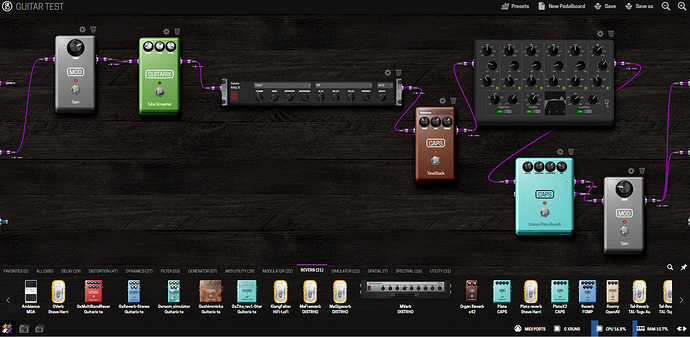The MOD team has raised $82,781 instead of the requested $65,000 at Kickstarter and is planning to deliver their new Linux-based multieffect pedal to musicians around June 2015.
Essentially, MOD Duo is an ARM-based specialized computer with an audio interface that runs Linux and is controled via web interface from your laptop, tablet, or phone. All effects are written using free/libre LV2 API and can be freely connected like nodes in a graph which alone makes MOD unique.
The project started in 2008 with an idea to create a truly customizable multieffect pedal that could be upgraded.
Over the time I got tired of buying new equipment every time I wanted to do something new.
Gianfranco Ceccolini, MOD founder
The project got its first share of Internet’s attention last year thanks to participation at Linux Audio Conference 2013. We’ve seen both praise for using Linux and relying on the open LV2 API, and scepsis regarding industrial design, the choice for Intel Atom for MOD Quadra (the first model in the series), and the price which was around $1K.
Given the price, MOD Quadra did look a bit pale in comparison to Line6’s AMPLIFi FX100 (which received its own share of mixed reviews). But it was about to change, and it did.
Inside and outside
Earlier this year Gianfranco Ceccolini mentioned in a private conversation that they were planning to launch a Kickstarter campaign and move the production to the USA to get rid of the “cost of Brazil” where the company was originally located. The expected price of MOD Duo was estimated to drop to $400 which was still a lot, but already bearable.
They actually did more than that: the cheapest option among Kickstarter perks, the early bird release, was available for $299 during the campaign. But the hardware changed as well.
Instead of Intel Atom N2800 1.8GHz with 2GB RAM and 8GB, MOD Duo got Dual Core ARM A7 1.0GHz, 1GB RAM, and 4GB Flash Storage. And even though the campaign was done $1.5K short of reaching the $85K stretch goal to put 8GB memory inside, the team made a decision to do it anyway. Also, Duo is getting differential balanced outputs thanks to supporter who pushed the campaign through the $75K stretch goal and onward.
The current audio interface is 24/48, and it has 104dB dynamic range. The interface is USB class compliant, and there’s an RJ-45 for additional controllers.
Speaking of which, you can hook up to 8 different peripheral units (expression pedals, footswitches, Arduino Shields) to the same MOD. This will come in handy, since Duo only has 2 controls and 2 LEDs on board.
Cost and hardware weren’t the only thing that changed though. Switching to ARM meant making sure all audio effects worked well on another platform. And yes, the switch did affect performance.
According to Gianfranco Ceccolini, it’s difficult to compare Intel and Atom here, but the team did see performance boosts in case of pitch shifters and distortions. Once measurable example is CAPS Cabinet IV which went form 125% CPU load to 8%. Some plugins still run better on Intel though.
The software
Since we last covered MOD in May 2013, the team made quite a progress towards delivering more and better plugins. They also made quite a few upstream contributions, most notably for the Guitarix project (they are also donating part of the Kickstarter money to LV2 plugins’ developers).
Here’s a video that features a simple processing chain made of LV2 versions of two (originally, LADSPA) TAP and CAPS plugins, ArtyFX’s Roomy reverb, and MOD’s own gain plugin.
There is some progress on both note/pitch detection and looping which were lacking for MOD Quadra last year. For the looper, the team reused Sooperlooper which they ported to LV2, admittedly, in a simplified form (interestingly, Guitarix recently released an update which features their own looper additionally available as an LV2 plugin).
The note-to-midi plugin that could be useful to turn MOD pedals into guitar synthesizers is currently in alpha shape, makes a lot of CPU use and doesn’t yet “read” chords. But the idea the developers have been toying with is to put a small DSP inside the hardware, connected directly to the input, and thus implement the note detection directly on hardware.
Finally, they recently rolled out the social service where MOD users can share presets. It’s part of the original concept. It’s not exactly a new thing: Fender has been doing it with their FUSE software for a few years already, and, of course, there’s Line6 recent enterprise.
What’s different is that you see what presets are made of, and the preset can have a Vimeo video attached. It’s still missing votes and sorting though.
In conclusion
MOD is a very interesting project to watch. They are open source guys through and through: they release both original and modified code on GitHub, and they aim to financially support developers whose code they reuse.
But they also care about the sound, they understand the zeitgeist and the drive towards social interaction, and, which is still incredible for free/libre projects, they can produce promo videos worth watching, and they don’t try to save a few bucks at the cost of web design.
At that, MOD combines all the good things one associates with free/libre software, and sensible business approach. It looks like the project might very well have a rather interesting future.
Featured image at the top by Zynthian project.
Patreon subscribers get early access to my posts. If you are feeling generous, you can also make a one-time donation on BuyMeACoffee.

